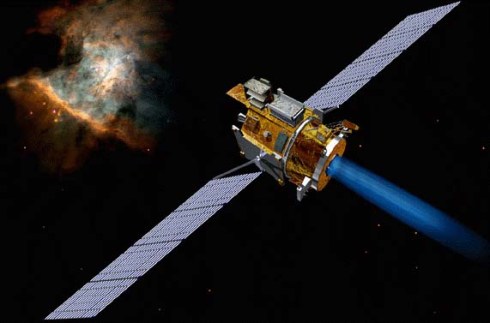You are currently browsing the tag archive for the ‘probe’ tag.
Today a winter snow storm has transformed Brooklyn into a huge ice ball–at least metaphorically speaking–but the weather will surely improve. Home will not be a ball of ice forever. The same cannot be said for the Philae robotic lander which is currently aboard the European Space Agency’s Rosetta spacecraft (which, in turn, is currently in outer space returning to the inner solar system after 31 months in the dark cold outer solar system). If all goes according to plan, the Rosetta spacecraft will enter a slow orbit around comet 67P/Churyumov–Gerasimenko in May of 2014. Once the space probe is in orbit around the comet, it will (eventually) fire the Philae probe onto the comet itself. Philae is equipped with space harpoons to latch on to the comet’s surface and cling to the hurtling slushball. Once there, the little robot lander will assay the comet with its drill and ten onboard sensors in order to learn more about the birth of the solar system–when the comet (probably) came into existence.
There are many remarkable aspects to this astonishing mission (which launched a decade ago), but one of the most harrowing periods just ended. Because the spacecraft is powered by solar panels, it did not receive sufficient energy to operate during its long sojourn through the outer solar system. For two-and-a-half years, the mission controllers in Darmstadt, Germany have been in suspense waiting to see if Rosetta had survived being all but shut down (because of a last-minute mission rewrite, the craft was not designed for any such suspended animation). Yesterday the spaceship woke up and radioed back to Earth! The mission is on! I can hardly wait for May (for multiple reasons).
Today (September 12, 2013) NASA announced that Voyager I has officially left the solar system. The probe is the first human-made object to enter interstellar space: it is farther away from Earth than anything else people have ever made. Launched on September 5, 1977, Voyager’s primary mission was to fly by Jupiter and Saturn and take pictures (and electromagnetic radiation readings) of the two worlds and their systems. The probe reached Jupiter in 1979 and Saturn in 1980. After a close fly-by of Titan, the moon with an atmosphere, the spacecraft was flung out of the plane of the solar system. Only this summer has it reached the heliopause, where the sun’s electromagnetic energy is matched by the ambient energy of the cosmos (although since only minimal instruments are running on Voyager, astrophysicists may be a long time arguing about when exactly the craft slipped out of the solar system).
Voyager is not moving as quickly as the solar probes mentioned in yesterday’s post, but neither is it moving slowly (its current velocity is 38,000 miles per hour). However such speed is minimal in the face of interstellar vastness (although Voyager is due to pass within 1.6 light years of the red dwarf star Gliese 445 in 40,000 years).
NASA has recently released plans for a new ion thruster capable of propelling spacecraft to the astonishing speed of 90,000 miles per hour (the thruster is named NEXT–an unnecessarily clever acronym which is short for “NASA’s Evolutionary Xenon Thruster”). Reading about the thruster’s blazing speed made me wonder: what exactly is the fastest human-made item ever? The answer was not what I expected—or rather it was exactly what I expected, but it happened a long time ago.
To escape Earth’s gravitational pull, an object must already be traveling around 25,000 mph, so ICBMs and orbital space craft are fairly speedy anyway. Interplanetary probes are the fastest objects we humans have crafted, although they tend to obtain their velocity by means of using the gravity wells of planets or the sun to “sling” off at a higher velocity. In 1976, NASA launched the solar probe Helios 2 to measure electromagnetic radiation emanating from the sun and to calculate solar magnetic fields. The eccentric orbit of Helios 2 resulted in the craft reaching a top speed of 157,078 miles per hour. If the probe were running along the equator, it could whip around the Earth six and a third times during an episode of “The Bionic Woman” (or whatever other hour-long show was playing in 1976).
Helios 2 has held the record for being the fastest man-made object since I was a toddler, but NASA has finally decided to rise to the challenge (since nobody else apparently has the know-how or the desire to push mankind forward). Solar Probe Plus is a NASA mission planned for launch in 2018 which features a robot space probe which will travel to the outer corona of the sun (assuming feckless American lawmakers don’t scrap the mission). When the probe is closest to the sun it will be a mere 5.9 million kilometers (3.67 million miles) from the photosphere of the star and it will be traveling at a blistering 432,000 miles per hour. The insane temperature and radiation which Solar Probe Plus will face at such proximity to the sun will necessitate that the speed demon robot must take shelter behind a carbon fiber reinforced carbon shield as it blasts through the outer corona at a fifteen hundredths the speed of light (it turns out light is still incomprehensibly fast compared to our very fastest things).
(Coincidentally, long time readers might wonder why I have abandoned my usual convention of citing measurement values in metric and then following them with U.S. customary measurements in parenthesis. The answer, alas, is laziness. All of the sources about really fast things use miles per hour and I didn’t feel like converting. If you are so inclined, you can easily convert to kilometers per hour (or parsecs per second, or whatever) using the internet. Alternatively, you could write me an angry letter in French.)
Humankind is always fixating on the Moon and Mars as the most likely spots for the first space colonies, but there is another crazy possibility. Aside from the Sun and the Moon, Venus is the brightest object in the night sky. Earth’s closest planetary neighbor, Venus is a veritable sister planet with extremely similar mass and volume. Because of its size and position in the solar system, a great deal of early science fiction concentrated around Venus. Dreamers and fabulists posited that beneath its ominously uniform cloud cover was a lush tropical rainforest filled with lizard people and pulchritudinous scantily clad women (the fact that the planet’s Greco-Roman name is synonymous with the goddess of love and beauty seems to have influenced many generations of male space enthusiasts).
Alas, the space age quickly dispensed with mankind’s sweaty-palmed fantasies about life on Venus. In 1970 the Soviet space probe, Venera 7, was the first spacecraft to successfully land on another planet (after a long series of earlier space probes were melted or crushed by atmospheric pressure). In the 23 minute window before the probe’s instruments failed, the craft recorded hellish extremes of temperature and pressure. The temperature on Venus’ surface averages around 500 °C (932 °F), (higher than the melting point of lead) and the pressure on the ground is equal to the pressure beneath a kilometer of earth’s ocean. The planet’s surface is a gloomy desertlike shell of slabs interspersed with weird volcanic features not found elsewhere in the solar system (which have strange names like “farra”,” novae”, and “arachnoids”). Additionally the broiling surface is scarred by huge impact craters, and intersected by immense volcanic mountains (the tallest of which looms 2 kilometers above Everest). The tops of these mountains are covered with a metallic snow made of elemental tellurium or lead sulfide (probably).
The atmosphere of Venus is a hellish fug of carbon dioxide which traps the sun’s energy in a self replicating greenhouse gone wrong. Above the dense clouds of CO2, the upper atmosphere is dominated by sulfur dioxide and corrosive sulfuric acid. Once Venus may have had water oceans and more earth-like conditions, but rampant greenhouse heating caused a feedback loop which caused the planet to become superheated billions of years ago. Without an magnetosphere, solar winds stripped Venus of its molecular hydrogen (yikes!).
Thus Venus does not initially present a very appealing picture for colonization! Yet the planet’s mass is similar to Earth (and humans’ long term viability in low gravity is far from certain). The planet is closer than Mars and windows of opportunity for travel are more frequent. Fifty kilometers (30 miles) above the surface of Venus, the temperature is stable between 0 and 50 degrees Celsius (32 to 122 degrees Fahrenheit). Light crafts filled with oxygen and nitrogen would float above the dense carbon dioxide. Today’s visionaries and dreamers therefore have stopped thinking of tropical jungles and envision instead a world of Aerostats and floating cities. Although the rotation of Venus is too slow to craft a space elevator, the flying colonists of Venus probably could build some sort of skyhook with existing or near future technology. Such a hook could be used to lift raw materials from the surface to manufacturing facilities in the skies. As more aerostat habitats were built, the colony would gain manufacturing strength, safety, and a greater ability to alter the barren world below (increasingly overshadowed by flying cities and hovering countries).
Imagine then a world like that of the Jetsons where the surface was unseen and not thought about (except by scientists and industrialists). Floating forests and croplands could be assembled to mimic earth habitats and provide resources for a bourgeoning population of Venusian humans. Skyships would cruise between the flying city states dotted jewel-like in the glowing heavens. Over time these flying habitats could be used to alter the planetary temperature and shield the desolate lands below. Humankind and whatever friends and stowaways came with us would finally have a second home in easy shouting distance of Earth. How long would it be then before we took steps to take Earth life even farther into the universe?


















